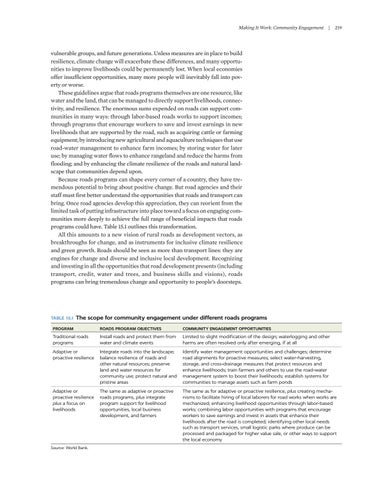Making It Work: Community Engagement | 219
vulnerable groups, and future generations. Unless measures are in place to build resilience, climate change will exacerbate these differences, and many opportunities to improve livelihoods could be permanently lost. When local economies offer insufficient opportunities, many more people will inevitably fall into poverty or worse. These guidelines argue that roads programs themselves are one resource, like water and the land, that can be managed to directly support livelihoods, connectivity, and resilience. The enormous sums expended on roads can support communities in many ways: through labor-based roads works to support incomes; through programs that encourage workers to save and invest earnings in new livelihoods that are supported by the road, such as acquiring cattle or farming equipment; by introducing new agricultural and aquaculture techniques that use road-water management to enhance farm incomes; by storing water for later use; by managing water flows to enhance rangeland and reduce the harms from flooding; and by enhancing the climate resilience of the roads and natural landscape that communities depend upon. Because roads programs can shape every corner of a country, they have tremendous potential to bring about positive change. But road agencies and their staff must first better understand the opportunities that roads and transport can bring. Once road agencies develop this appreciation, they can reorient from the limited task of putting infrastructure into place toward a focus on engaging communities more deeply to achieve the full range of beneficial impacts that roads programs could have. Table 15.1 outlines this transformation. All this amounts to a new vision of rural roads as development vectors, as breakthroughs for change, and as instruments for inclusive climate resilience and green growth. Roads should be seen as more than transport lines: they are engines for change and diverse and inclusive local development. Recognizing and investing in all the opportunities that road development presents (including transport, credit, water and trees, and business skills and visions), roads programs can bring tremendous change and opportunity to people’s doorsteps.
TABLE 15.1 The
scope for community engagement under different roads programs
PROGRAM
ROADS PROGRAM OBJECTIVES
COMMUNITY ENGAGEMENT OPPORTUNITIES
Traditional roads programs
Install roads and protect them from water and climate events
Limited to slight modification of the design; waterlogging and other harms are often resolved only after emerging, if at all
Adaptive or proactive resilience
Integrate roads into the landscape; balance resilience of roads and other natural resources; preserve land and water resources for community use; protect natural and pristine areas
Identify water management opportunities and challenges; determine road alignments for proactive measures; select water-harvesting, storage, and cross-drainage measures that protect resources and enhance livelihoods; train farmers and others to use the road-water management system to boost their livelihoods; establish systems for communities to manage assets such as farm ponds
Adaptive or proactive resilience plus a focus on livelihoods
The same as adaptive or proactive roads programs, plus integrate program support for livelihood opportunities, local business development, and farmers
The same as for adaptive or proactive resilience, plus creating mechanisms to facilitate hiring of local laborers for road works when works are mechanized; enhancing livelihood opportunities through labor-based works; combining labor opportunities with programs that encourage workers to save earnings and invest in assets that enhance their livelihoods after the road is completed; identifying other local needs such as transport services, small logistic parks where produce can be processed and packaged for higher value sale, or other ways to support the local economy
Source: World Bank.







































